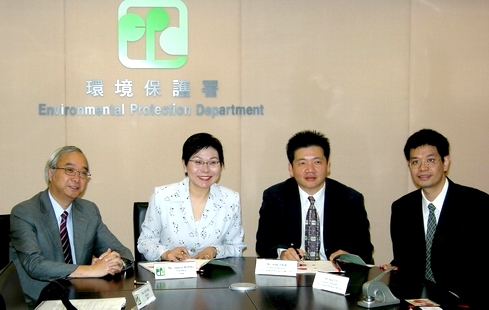A Study to Review Hong Kong's Air Quality Objectives
The Environmental Protection Department had, in June 2007, commissioned a comprehensive study to review Hong Kong's Air Quality Objectives (AQOs) and develop a long-term air quality management strategy. We completed the Study in mid 2009, the findings of which are now provided in the Consultation Document and the final report in detail.

The study examined the latest findings on review of air quality standards by the World Health Organisation, the European Union and the United States. It also considered factors including protection of public health, cost effectiveness, society's expectation, maturity of the technologies needed, time required for introducing the measures, the need to work with the Mainland as well as impacts on other policy areas such as energy, transportation, industrial development, urban planning and conservation for devising a new set of AQO and a long-term air quality management strategy and measures for Hong Kong.
The review included a thorough public consultation and engagement process. To ensure that the study would be properly conducted, we had set up an Advisory Panel on Review of the Air Quality Objectives and Development of a Long Term Air Quality Strategy to guide the study. The Advisory Panel comprised members from the Advisory Council on the Environment, experts from different sectors, academics of relevant disciplines and representatives from relevant policy bureaux of the Government. The Government will finalize the new AQO and the required long-term strategy on air quality management after carrying out a comprehensive public engagement on the Air Quality Objectives review.
Consultations Forums
The Environmental Protection Department had conducted a number of consultation forums in relation to the review of Hong Kong's AQO. You can access the presentation materials and the ensuing discussions at the links given below:
2007-12-18 Consultation Forum for the Professionals (in English only)
2008-01-31 Consultation Forum for the General Public (mainly in Chinese)
2009-03-20 Consultation Forum for the General Public (mainly in Chinese)
Study Reports
The review study has been completed. Please click below the final report and executive summary for the findings of the review study.
Final Report and Executive Summary
International Developments on Air Quality Objective (AQO) Review
We have been monitoring the international developments on review of air quality standards and objectives with a view to examining the need for revising Hong Kong's AQOs from a scientific perspective, taking into account local circumstances. Recent scientific research findings suggest that particulate matters smaller than 2.5 microns have more direct health effects than those of larger sizes. Moreover, the concentration levels of air pollutants capable of affecting human health may be lower than those indicated in previous studies. In view of such findings, in recent years, a number of countries including the United States of America (US), the Member States of the European Union (EU) and the World Health Organisation (WHO) have been examining the need for introducing a new set of air quality standards for particulate matters smaller than 2.5 microns (i.e. PM2.5) and revising the current air quality guidelines and standards.
The WHO announced in October 2006 an updated set of Air Quality Guidelines (AQGs). The new AQGs provide a scientific basis for supporting the development of air quality policies and management strategies in various parts of the world to protect human health. Owing to the stringency of the new AQGs, the WHO has recommended interim targets in the new guidelines for countries to improve their air quality progressively.
The WHO clearly points out that the actual air quality standards set in each country will vary according to the approach adopted for balancing health risks, technological feasibility, economic considerations and various other political and social factors. It also advises that governments should consider their own local circumstances carefully before adopting the new AQGs as statutory standards.
The government of the United Kingdom (UK), in its consultation document published in April 2006, considered it impracticable to fully achieve the air quality standards recommended by the WHO. The UK estimated that it could only meet the standards for some air pollutants, e.g. particulates, by 2050. In July 2007, the UK published their latest Air Quality Strategy introducing new annual average and background exposure reduction for PM2.5 to be achieved by 2020. The US Environmental Protection Agency (EPA) announced new air quality standards for particulate matters and ozone in late September 2006 and mid-March 2008, respectively. These new standards are less stringent than those in the new WHO AQGs and the years for meeting the targets range from 2014 to 2031. In May 2008, the EU finalised a directive on ambient air quality which includes a PM2.5 annual average standard to be achieved by 2015. Again, this new PM2.5 standard is less stringent than that in the new WHO AQGs.